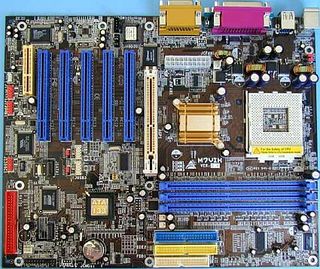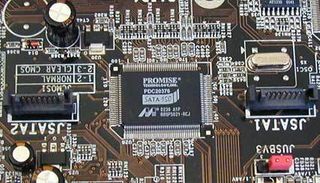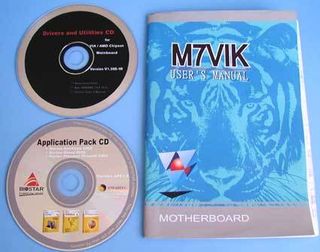DDR400 for Athlon: A Comparison of 9 Motherboards
Biostar M7VIK

Board revision: 1.0
BIOS version: 0910F (September 10, 2002)
When you stop by the Biostar website these days, the very first thing to catch your eye is the M7VIK. Biostar highlights the board's DDR400 capability and the FSB clock of 166 MHz, among other things. In our test, both of these features worked flawlessly, but the Biostar board is just a bit slower than its competitors. On the other hand, the correct clock speed is maintained to the letter. A CPU clock of 1,799 MHz and an accurate 133.31 MHz FSB are exactly up to specifications - there are other manufacturers who occasionally like to cheat with minimally increased clocks.
The first thing to strike you is Biostar's colorful board: it has three blue DIMM sockets; five PCI slots that are also blue; and red, yellow, white and blue ports for the ribbon cables... it seems that the developers' creativity superseded any logical considerations. Different strokes for different folks... the layout itself gives no reason to gripe.

Like Asus and MSI, Biostar also uses the current Serial ATA controller from Promise (PDC20376), which can address as many as four Serial ATA drives. Two ports are on the board, the other two fell victim to a conventional IDE port.

The package includes two ribbon cables - one for the IDE drives and another to hook up a floppy disk drive. The board also comes with two Serial ATA cables which, unfortunately, are just as short as the ones that come with the Asus board. There's no way you can reach drives that are in the upper part of a tall tower with these cables. After the adapter cable (in the picture above) has been correctly hooked up, three FireWire ports are available - more than the competition provides.

The manual is very comprehensive. The two CDs have lots to offer: while the first (above) has drivers and utilities, the second CD has a so-called Application Pack, containing three extremely useful Norton programs. These are: AntiVirus 2002, for fending off dangerous software; Ghost 2002, for making backups of entire partitions or hard drives; and Personal Firewall 2002, for protecting your Windows PC from attacks from the Internet.
Stay on the Cutting Edge
Join the experts who read Tom's Hardware for the inside track on enthusiast PC tech news — and have for over 25 years. We'll send breaking news and in-depth reviews of CPUs, GPUs, AI, maker hardware and more straight to your inbox.

The packaging is as simplistic as the board is colorful - an elegant look, but with low brand-recognition value.
Most Popular

